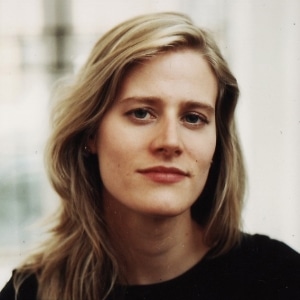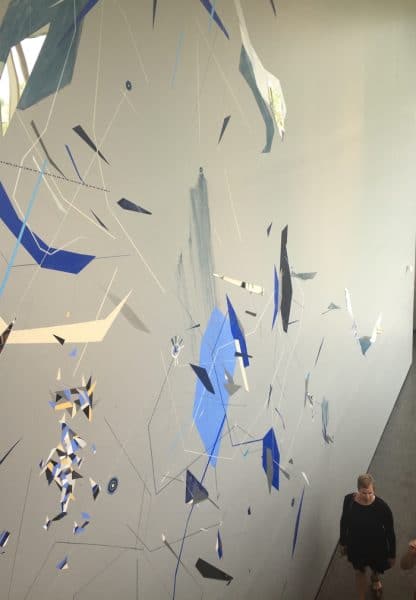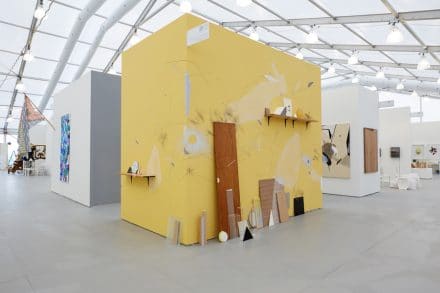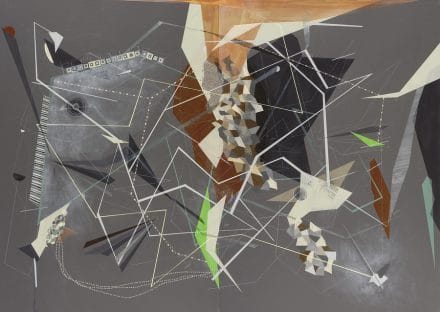
CHF 2014 grant recipient Dannielle Tegeder is a painter who also creates large-scale installations, drawings, animations, mobiles, and other sculptural objects. Our funding helped to support Infrastructure, her solo exhibition at the Montclair Art Museum in New Jersey, which runs until June 30, 2017. Her work has been presented in more than 100 gallery exhibitions, as well as at institutions such as PS1/MOMA, the New Museum, and the Museum of Contemporary Art in Chicago. She’s also an associate art professor at the City University of New York’s Lehman College.
In a recent interview with CHF Editorial Director Sofia Perez, Dannielle discussed the challenges of balancing financial concerns against those projects that are designed to further one’s career trajectory. She also urged young artists to create their own opportunities and seek the support of their peers.
SP: Tell us a little bit about Infrastructure, the exhibition that CHF helped to fund. It was partly inspired by growing up in a family of steamfitters, right?
“…I tell [my students] that the Virgin Guadalupe of Gagosian is not going to come down to their studios for a visitation and say, ‘Here’s a show. Everything is great now, so you don’t have to worry.’ That is not happening….”
DT: I was invited to do a site-specific project at the Montclair Art Museum, and also a series of animations that were based on my drawings. The animations are being screened on the grounds, and the museum also acquired one of the drawings. I was interested in the space where the project is housed: the wall installation and mobile are in a stairwell area that’s enclosed in glass and can be viewed from outside.
The piece comes from two places. One is really personal. I grew up doing a lot of mechanical drawing and drafting, learning that from my family. The invisible architecture inside buildings—all the plumbing and heating—becomes a metaphor for how we’re all connected to one another, and to the other invisible systems around us. Then, of course, the work is also informed by the history of design, architecture, and modernism.
SP: The exhibition was supposed to open in 2015, but it was delayed because the curator was expecting her first child. How do you deal with unforeseen setbacks like that?
DT: There were a bunch of logistical and scheduling issues that moved things around. I had to deal with funding—talking to CHF to see if we could extend things, and talking to my fiscal sponsor as well. It’s good to have more time, but it’s also challenging because then the project starts to overlap with other projects. Those changes mean keeping the level of communication open. There’s this impression that artists work alone, but the reality is that I have a studio manager, funders, the folks at the museum, and their education department. There are ten people involved in the scheduling of this one project. So it definitely means a lot of communication and a lot of managing.
SP: How much ongoing promotion has the museum done for the event, and have you done your own PR?
DT: I met with the museum’s PR department, and they assigned someone to the exhibition. We’ve shared contacts, and they’ve reached out to press, but I do my own PR, too. I made a PR packet, and I try to think about which press would be interested in writing on architecture and other facets of the project. It’s definitely a team effort.
SP: CHF awards grants to support projects that we expect will boost artists’ careers. What role has this exhibition played in your career trajectory?

DT: This is a really significant show for me. Montclair has a very knowledgeable base of collectors. The curator [Alexandra Schwartz] is highly regarded—she originally came from MoMA. The process of working with a museum allows you to get more used to the experience, and it’s a platform for other museum projects. Also, the fact that the exhibition is going to remain up for a year is hugely important. I hope that someone acquires the mobile, but the wall installation will eventually be painted over, so it’s an ephemeral project. It’s not like a painting that will go on and live for many years. It’s a very different animal.
SP: How do you use the success of this show to generate other work, and build it into something that’s sustainable from the business side?
DT: Of course I like to sell my work, and that is part of sustaining myself as an artist, but it’s a much more complex picture than that. You could sell a lot of work, and not really have a career in any way. There’s that double-sidedness to it. Beyond selling your work, you need to be in highly regarded exhibitions and museums. Your work needs to be acquired by museums and written about. It goes out on social media. It goes on your bio. All of it feeds back into sustaining yourself.
SP: You have to balance the financial decisions against those that are made with an eye toward your career trajectory.
DT: Yes, and it gets harder as I get more successful. Should I do a particular exhibition? What’s the return on it—monetary or otherwise? Those questions are difficult. From the outside, the Montclair show might seem like it’s not a very smart prospect for me. I created a 30-foot wall drawing, but it’s not a salable piece. We set up three installations in 100-degree heat over several weeks, and eventually it will come down, and I’ll lose all that work. But I also received funding from CHF, which puts me in that network, and the show connected me to the museum’s board, who bought a large-scale drawing from me that will be in the museum’s collection forever, I hope. That purchase helped to fund the exhibition. The show also connected me to a number of significant collectors who may be interested in paintings I do in the future.
It’s really a balance. It’s not banking. It’s more like high-stakes gambling. You can be strategic, but sometimes you do a project, and you think, “Why am I doing this? Nothing is going to come from this.” And then you end up getting a major sale, or a New York Times review. And sometimes, you think you’ll get something out of it, and it doesn’t come to pass. I talk about this with other mid-career artists all the time, and this has happened to all of us.
SP: It’s an investment in your career, but how do you plan for that when you know that the financial return might not come for two or three years down the road?
DT: I think the majority of artists do not plan. I think many artists are just simply overextended, and hoping for the best. That’s an honest answer. For me, this has gotten to be a central question for my practice because I’ve rented a second studio and hired two more studio assistants. My overhead is high, and installations often include traveling and a lot of expenses. I try to weigh things and budget much more than before.
“…It’s almost unethical to not talk about [business in art school]. Otherwise you graduate, and you wonder how to approach a gallery, or sell a painting, or price your work. There’s so much to know…”
I wish I had an easy answer, but it’s impossible to know what’s going to happen in three months or six, especially with the upcoming election. It’s all very volatile. Right now, I’m selling a lot of work, but I’ve been in the game long enough, and have been through one crash. Artists who are five or ten years older than me have been through two crashes. They know what it’s like to have five galleries one year, and none a year later.
I also sustain myself by being a professor at CUNY. I love to teach so I don’t do it just for the money, and I could never run my studio just on my teaching salary alone, but it helps me know that I’m not going to be completely destitute if the bottom falls out. And inevitably it will, because that’s how it’s always gone.
SP: Sounds like you have to have a lot of irons in the fire at all times.
DT: Absolutely. I’m doing installations. I’m selling work. I’m doing public art. I’m teaching. I think the idea that artists are going to be in their studio and simply sell their artwork is rarely the truth. Artists have multiple income streams—that’s a much more realistic picture. Even among the most successful artists I know, there are those who were making lots of money five years ago, and now they’re not. It goes up and down.
SP: How do you manage the day-to-day logistics of that? Do you do budgeting, inventory tracking? Do keep data on how your business is trending?
DT: I have people helping me now. I have an excellent accountant who focuses only on professional artists. I have a studio manager who is with me four full days a week. Even with my studio manager, I could still go in and do administrative work all day, and not get to the art if I didn’t make a conscious effort to cut other things. I have a studio assistant and interns who help me. I have a baby-sitter who’s also an artist and helps in the studio. I have collectors who support me. And I’m part of a tight-knit group of female mid-career artists; when we have to make decisions, we often bounce them off each other. So I have a lot. The idea that artists do this work alone? There’s no way I could do it alone. I can barely do it with five people.
SP: How did this group of female artists come together? Was it organic, or did you all decide that you were going to set up something formal?
DT: A little bit of both. My studio is in the Elizabeth Foundation, the biggest artist residency in the country, with more than 70 artists from all over the world. They’re all professional working artists, and we’re in the same building together. We developed friendships, and we decided to create this group. I have lunch with an artist or somebody in this world almost every single day, so it was a natural extension of that.
We meet every two weeks to go through exactly these kinds of issues. “I have this situation with a gallery. What do you think?” Or, “I have this proposal. How should I approach this person?”
SP: Do you encourage other artists to look for like-minded peers to help each other out?
DT: Absolutely. Artists who try to go it alone often stop making their work. It’s just too difficult, and there’s so much business stuff to navigate that does not get taught in art school. Plus, there are social and emotional things. How do you deal with being rejected over a period of 20 years? No matter how successful you are, you’re going to have to face a certain level of rejection. It’s one thing to do it for a year, but it’s something else to deal with it for 20 years and not become bitter. All of these things come into play. When you’re in a group of artists, the camaraderie helps.
SP: How do you deal with rejection?

DT: When I got out of graduate school, I was making my work, but I was getting lots of rejections, and two of my closest friends got picked up by very big galleries in New York. Of course I was happy for them, but I was also completely devastated. In response, I made a pact with myself that I would take action whenever I got rejected or felt jealous of someone. I still do that to this day. To make sure that something doesn’t eat at me, I say, “Okay, let me write to a curator, or apply to a residency.” Or, “Let me put something out on social media.” That’s been my little trick.
It has nothing to do with how successful you are. I know very successful artists who are very bitter because there’s always another level of success to be achieved. You have to find a way to neutralize those feelings, and that’s been my weird way.
SP: That’s terrific. It gives you back some control over that situation.
DT: Yeah, I think it’s about being proactive. I joke about it with my graduate students all the time. I tell them that the Virgin Guadalupe of Gagosian is not going to come down to their studios for a visitation and say, “Here’s a show. Everything is great now, so you don’t have to worry.” That is not happening. No one’s coming.
In creative fields, there’s this romantic idea that you’re going to get something, and then it’s going to click, and everything will be taken care of. That’s a dangerous notion to have. There’s also this idea that gets passed on that artists are crazy or unstable, but that they can be saved by a gallery or a collector. Reality is much more complex than that.
SP: What other things do you try to teach your students, beyond artistic technique? Do you talk to them about the business side of the field?
DT: Definitely. It’s almost unethical to not talk about it. Otherwise you graduate, and you wonder how to approach a gallery, or sell a painting, or price your work. There’s so much to know. Years later, I’m still learning to navigate these things, and none of it was taught in school. If you’re choosing to get an MFA, I’m assuming you want to be a professional artist. Being a professional artist means you also have to navigate this stuff.
I recommend they take public speaking, and also take writing classes every single semester. Quite honestly, I think this is the biggest disadvantage for artists, period. All of a sudden, you’re writing five grants a week, or e-mails to curators; you need to be able to do those things. I also talk about going after residencies and other opportunities. Otherwise, you’re like a boat waiting for the winds to come.
SP: Are more artists learning about business than before? Is the industry changing?
DT: It’s changing a lot—in artists’ favor. When a collector tried to find your work 20 years ago, they had no other option than to go to a gallery. Now, with Instagram and other social media, you’re seeing artists take control of their careers, and in some cases cutting galleries out. If a collector wants to find my work, they can connect directly with me in five minutes, and many of them do. That’s a major advantage for artists. I think galleries still have a purpose; you don’t want to have to do all of that all of the time—at least I don’t—but you have more control than you’ve ever had.
SP: How can an artist who’s just starting out make the most of his/her relationship with a gallery?
DT: I often get asked, “How do I get a gallery?” It’s the wrong question. Artists—my professors—came to New York in the 60s because it was bombed out. It was cheap. There were maybe two galleries here. Those artists came to be with one another, and to collaborate and keep their overhead down so that they could make their work. They also did really innovative things that launched a lot of careers.
I encourage my students to discover the interesting artists around them. Collaborate, find places—whether it’s a storefront or an abandoned building—and do what you need to do to make your work. You need to think outside the white box rather than putting all your energy into finding a gallery. I’ve been through three galleries in New York. They’ve all closed. Even if you get one, it’s going to close 90 percent of the time. I tell these young artists, “You’re creative people. Think creatively about how you live your life.”
SP: You talked about promotion earlier. Do you have a branding strategy, a way to differentiate yourself as an artist?
DT: Like most artists I know, we freak out when we hear “branding strategy.” I have probably never uttered the word branding. It feels disingenuous. However, I do think that when you’re in touch with your work, and when you’re making it on a daily basis, there’s a natural way that you start to brand yourself because your practice gets deeper. Your images go out. Hopefully, people write about you. You have exhibitions. I do think, though, that it can be dangerous territory when artists think that way consciously, especially young artists.
I was just in Zurich, and I saw the Francis Picabia exhibition that is coming to MoMA. It’s a fascinating show because here’s an artist who has moved to a completely different style every five to ten years. The other example that comes to mind is Bruce Conner. If you didn’t know better, you’d think his work was produced by seven different artists. If you brand yourself too early—you’re 25, and you think, “Oh, I’m a figure painter,”—are you stuck with that? To me, that’s not what art is about. It’s about having possibilities rather than constraints.
SP: Have there been any watershed moments in your career?

DT: It’s an interesting question. It’s not like I was struggling and then suddenly I was saved by Gagosian, but there have been a few moments. I was living in Chicago, and I really wanted to come back to New York, which is where I’m from. I was awarded free studio space in New York for a year through the Marie Walsh Sharpe Art Foundation. It’s a very prestigious thing to get. You’re there with 12 other amazing artists. Once I was back in New York City, I ended up getting into a museum show and getting my first gallery. That was a real moment.
But I’ve also had solo shows, and all of them have been significant for me. I do think they all link to each other. Sometimes you do a show, and you think, “Oh, I’m getting nothing,” and then two years later, you get something from it. I don’t want to be elusive about this, but I also don’t want to put out this perception that you’re struggling, and then suddenly one thing happens. That has not been the case for me. It’s been much more of a continuous process with peaks and valleys, and it is still that way.
I think the other perception is, “I have a lot of shows under my belt, and it’s been a good year so now I can sit back.” In some ways, I can. I’m not in the same place as a young emerging artist. But it’s also not that different. I know a lot of artists who’ve had careers and then disappeared. That’s very common. The challenges facing career artists almost never get discussed. You’ve received attention, and now maybe you’re not getting as much.
SP: You have to be capable of adapting to the situation as it comes.
DT: Absolutely. I love my life, but ten years ago I don’t think I would’ve perceived that this is what it would feel like for me from the inside. I might’ve thought that you get to a point where everything is taken care of, and it’s all perfect, but that’s not how it goes. That’s not how life is.
CHF provides a platform for artists and industry leaders to share knowledge and expertise. Help us continue to provide these valuable resources by supporting our work.







